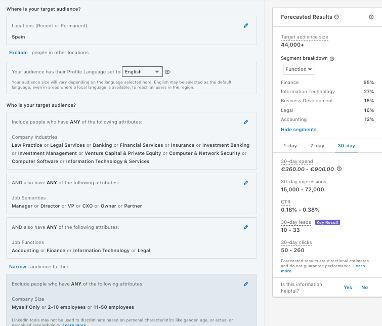Six insiders LinkedIn Ads targeting unknown tricks
Building a solid LinkedIn Ads targeting strategy is key for your campaign effectiveness. This is a blog post on six insiders LinkedIn Ads targeting unknown tricks. For broader targeting content, you can read this post, where we explain all segmentation options and some recommendations, or our LinkedIn Ads definitive guide.
LinkedIn Ads targeting unknown tricks
Inclusions vs exclusions
One of the six insiders LinkedIn Ads targeting unknown tricks is about inclusions vs exclusions.
LinkedIn allows to include and exclude any audience attribute by clicking Narrow to include and Exclude to take out those audience attributes you don’t want to impact. But, it’s important to know when it’s better to include or exclude. But it’s important to understand when you should include rather than exclude or vice versa.

Commonly, we may think it’s better including than excluding, but sometimes excluding is as important as including. When you include some attributes, it can exclude members of your target audience. That’s why it is important to test both options to see if you can increase your audience by excluding rather than including. For a better understanding, let’s explain it with two specific audience attributes. Company name targeting works better excluding than including audiences, unless you are targeting 500 companies.
Inclusions vs exclusions: example
if you only want to exclude the companies that are currently working with you, it’s better to exclude them than include the other companies you want to impact. This also happens with company size targeting. In order to understand it better, let’s explain it through an example:
Imagine you want to create a campaign in the UK. In the image we can see in the UK there is a total of 29 million members.

Now, let’s say you are interested in impacting members working in companies with less than 5,000 employees. What you typically would do is including members who work for companies of all the sizes less than 5,000. That’s ‘myself only’ ‘2-10 employees’, 11-50 employees’ and so on, The result is 8.6 million members.

The reason for this is that LinkedIn does not map every company with every criterium. Therefore, if you run an inclusion-based segmentation, other members will be excluded. However, the best option here would be to exclude companies with more than 5,000 members, the resulting number being higher. In this case, it will be excluded ‘5,001-10,000 employees’ and ‘10,001+ employees’. As shown in the image below, the exclusion way shows 25 million members.
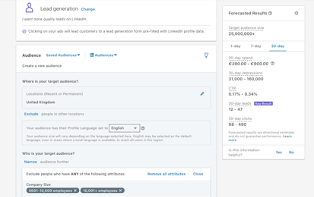
Profile language
When you start choosing targeting options, first, you need to add which locations you want to arrive, and then, the profile language. LinkedIn doesn’t allow multilingual campaigns. Choosing the English language, the campaign will impact users with local language too. But, if you decide to use the local language, it will only take the chosen language. So, depending on your goals and target audience will be better English or the local language.
Profile language: example
If you want to launch a campaign on Germany, you first have to select Germany on Locations. As shown in the image below, the result is 11 million members.
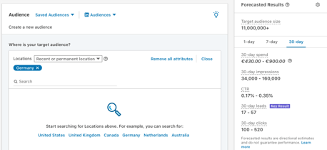
Then, if you decide to choose the English language, the result remains at 11 million members.
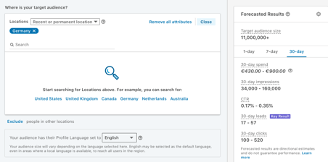
But, selecting the local language, in this case, German, the target audience size is reduced to 8.8 million members. So, choosing the local language excludes members. In addition, you need to consider that if you select the local language, the ads must be in the local language too.
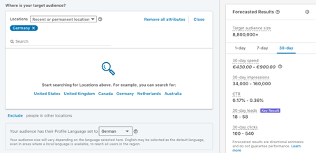
Audience expansion risks
The third insider LinkedIn Ads targeting unknown tricks talks about audience expansion risks.
Audience expansion option helps to get additional leads similar within your targeting selection.
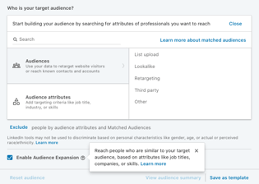
However, taking audience expansion option causes a loss of control the campaign as it expands the desired target beyond your segmentation. Sometimes, it can attract irrelevant leads which you never wanted to impact.
Audience expansion risks: example
For example, suppose you target by Job Function, Seniority of specific years of experience. In that case, the Audience Expansion can target people in that position with fewer years of experience in that role. May be for your campaign is important that users have minimum years of experience so that lead will be not qualified. We only suggest this option when the audience size is composed of 40.000 members. So, if your audience size is composed of 40.000 members, you can use the audience expansion option to impact more users. But, it’s important to analyse continuously the results to make sure the leads are qualified.
Targeting optimisation
One crucial aspect that is not mentioned by LinkedIn is targeting optimisation (as opposed to ads optimisation). When launching the campaign, play with the audience, based on the demographics report, and improve your ad performance.
On the image below, there’s a demographic report based on job functions where impressions, clicks and conversions results are shown.
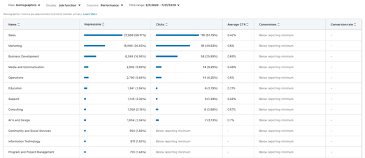
Also, you can compare results with the job title, company size, company industry, among others, to analyse if the targeting is optimising correctly, and in case not, conclude which targeting options you need to change.
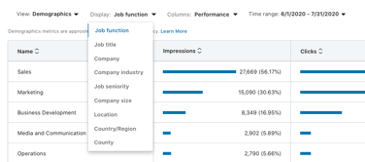
Entry-level for small companies
In most cases, it is not recommended choosing entry-level seniority. This seniority usually means that users don’t have leadership responsibilities, no advanced expertise, so, they are not decision-makers. Consequently, for those campaigns which require to arrive decision-maker users, Entry-level seniority won’t be a good option to select. However, if your target audience is composed of small companies is an optimal choice because if you decide not including this seniority, your audience size will probably be reduced.
Entry-level for small companies: example
Imagine you want to launch a campaign on Germany and impact users working in IT companies smaller than 10 employees. The audience size will be 46.000 members.
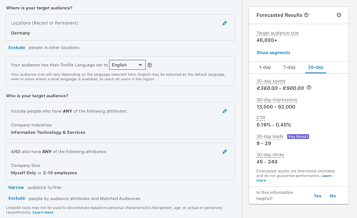
Then, you want to include Senior, Manager, Director, VP, CXO, Owner and Partner seniorities. So, the campaign will impact 32.000 members.

As it’s recommended to have an audience size of 40.000 members, it is better to include Entry seniority too. The target audience size increases to 43.000 members.
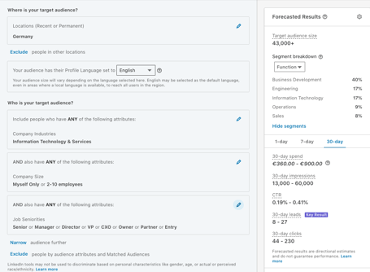
In addition, when launching the campaign, it’s important to analyse the results on a continuous basis to make sure the Entry-level seniority is giving qualified clicks and leads.
Don’t use more than four audience specs
The last six insiders LinkedIn Ads targeting unknown tricks is related to audience attributes.
LinkedIn says that it is important to not hyper-target the campaigns. But it is not said that is essential not using more than four audience specs. If you target with four audience specs, when launching the campaign, you can analyse what’s working and not to refine your targeting strategy as you consider. Also, there is a high risk of over-segmentation, because the audience size will be smaller, and it will be more challenging to analyse what’s performing and not.
Maximum of four audience specs: example
On the image below, there’s a target segmentation including specific company industries, job seniorities, job functions, member skills, years of experience and excluding company sizes. This example shows a hyper-target segmentation with 18.000 members.
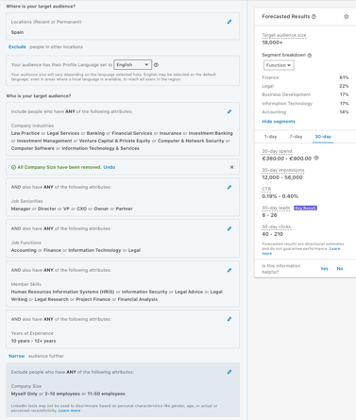
So, in this case, we recommend removing years of experience and members skills options. As a result, the target audience is composed of 44.000 members. It’s better to launch the campaign with a maximum of four audience specs. In case the campaign is not getting qualified leads, then we recommend changing or adding targeting options.
